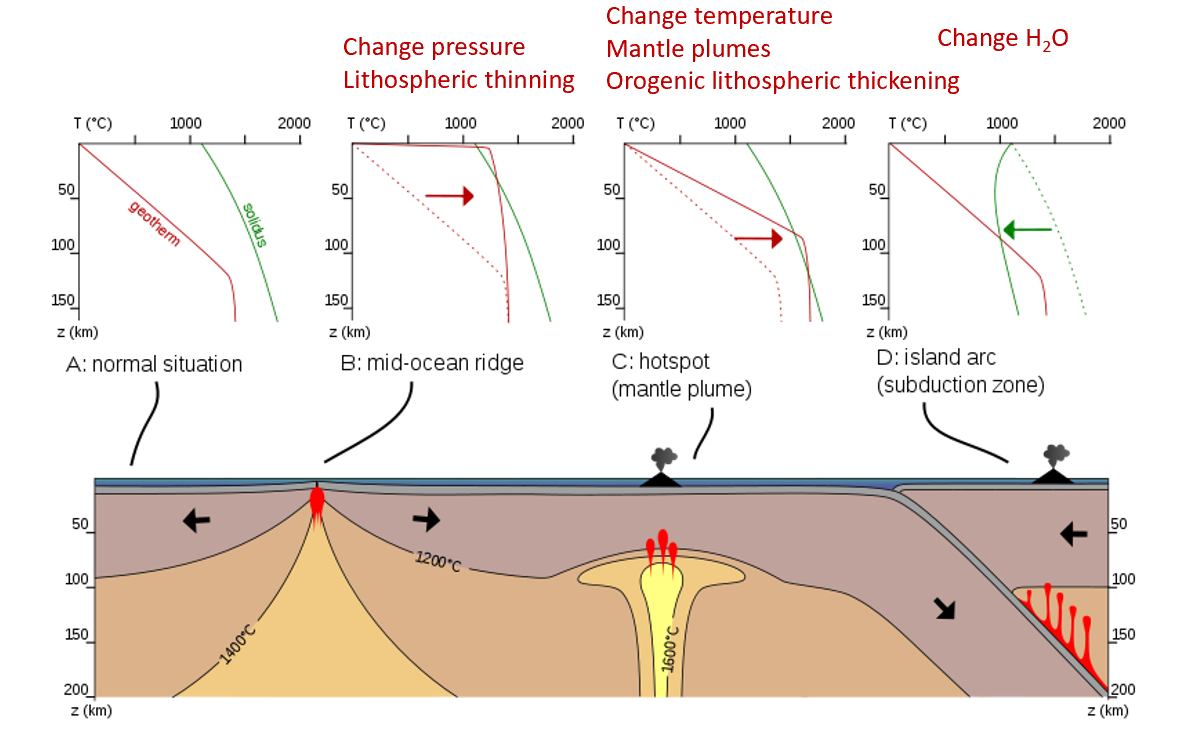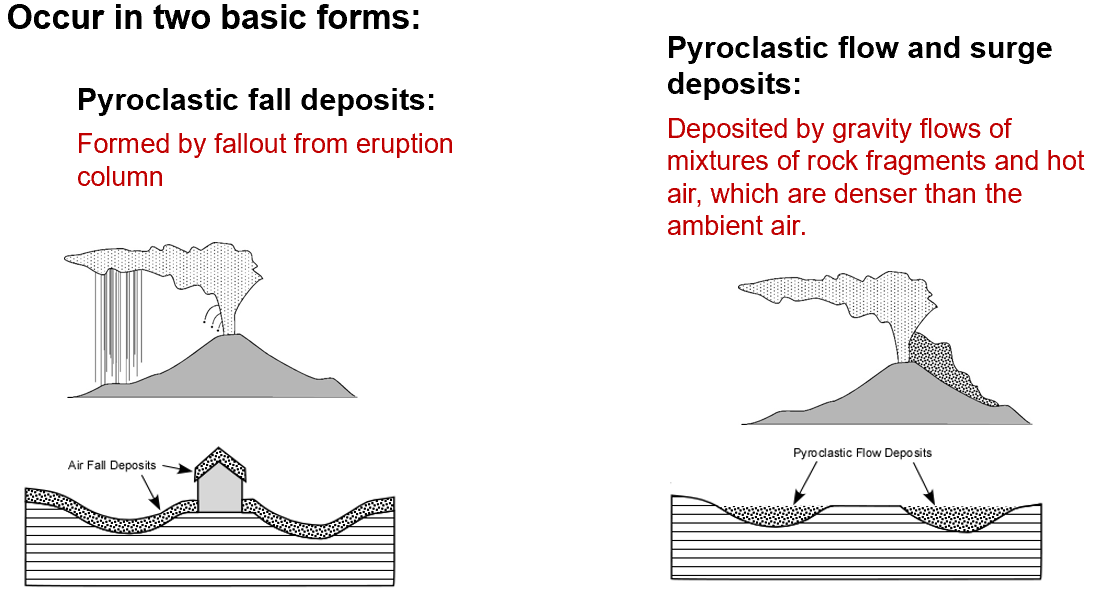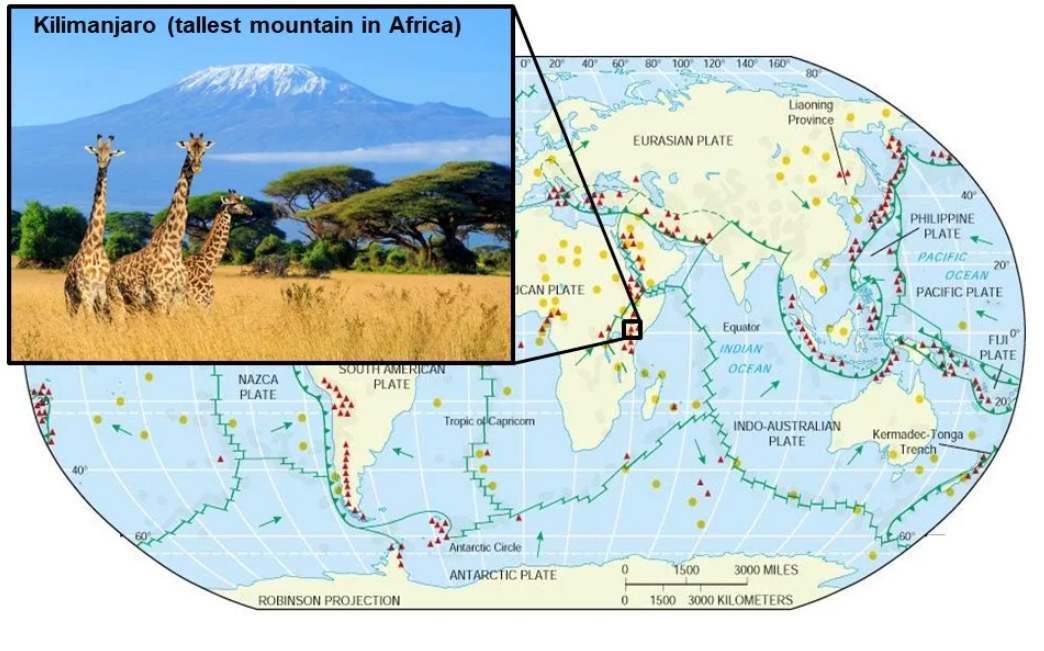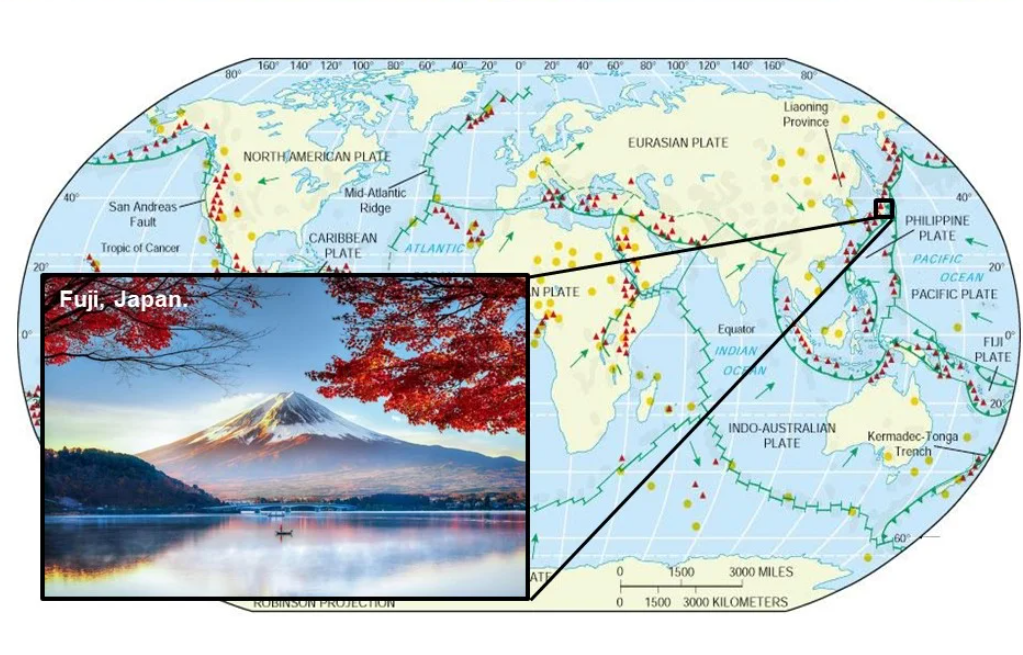3: Igneous Processes and Volcanoes
1/39
There's no tags or description
Looks like no tags are added yet.
Name | Mastery | Learn | Test | Matching | Spaced |
|---|
No study sessions yet.
40 Terms
recall the key rock-forming minerals
feldspars, quartz, olivine, pyroxenes, amphiboles and micas
explain where and how rock melts
crystallise from magma which is molten rock in the subsurface and usually consists of liquid silicate, crystals and gas bubbles
why do magmas form?
Interior of the earth is hot:
accretion of planetesimals = kinetic energy = heat
initially so hot that most of it melted
gravitational energy from iron sinking to the core
radioactive decay
continental crust
andesitic ‘intermediate’; quartz, feldspar, Fe, Mg
Upper Mantle
peridotite ‘ultrabasic’; olivine and pyroxenes
oceanic crust
basaltic ‘basic’; olivine, pyroxenes and plagioclase
what happens to melting point with increased pressure and depth
it increases
this is shown by the solidus line: melting occurs when the geotherm intersects this
explain why molten rock is typically either felsic (acidic) or mafic (basic) in composition
Magmas can be derived from mantle or crust. Composition is determined by:
Composition of the source rocks
Degree of partial melting
IRL total melting rarely happens due to differing melting points of minerals and Ts not high enough
Magmatic differentiation:
lower T minerals melt, leaving behind residual higher T minerals
results in a melt that is more felsic
Also, Melting usually occurs in the asthenosphere (ultrabasic) or lower continental crust (intermediate) (~100km) through the partial melting of mantle peridotite
mafic vs felsic
mafic contains less silica and is darker in colour
felsic rocks contain more silica
melting due to decompression (asthenosphere)
most common cause in practice
oceanic crust is extended and thinned - this removes the lid over the mantle and the shallow geothermal gradient is steepened
no heat is introduced, basaltic melt is produced through partial meltinf of the peridotite mantle
this is how oceanic crust is produced at mid-ocean ridges
basic
melting due to addition of water (continental crust)
Adding of water to crystal structure of a mineral - usually creating a new mineral
opposite of weathering reactions
changes fundemental properties of rocks incl melting temperature
water added via subduction
felsic
melting in orogenic belts (continental crust)
complex, fundementally by heating
continental-continental collision results in doubling of crustal thickness
cold underlying slab is warmed, rock is a bad conductor of heat so the thich continental crust cannot lose radiogenic heat fast enough = results in heating of crust above granite solidus
felsic melts
describe the key characteristic of intrusive igneous rocks in hand specimen and explain how they formed
coarse-grained texture, resulting from the slow cooling of magma beneath the Earth's surface. This slow cooling allows large mineral crystals to form.
less dense
atoms are more randomly and less efficiently organised
viscous (can flow) but this varies
intrusive melts cool slowly as the rock is a poor conductor
melting distance/temp graphs

where do magmas go?
magmas rise (less dense, viscous) and can:
crystallise beneath the earths surface
→ deep (>2km) - plutonic, fine grained
→ shallow (<2km) - hypabyssal, between plutonic and volcanic
erupt at earths surface
→ volcanic, fine grained
what determines magma composition
Composition of the source rocks:
→ mantle peridotite = ultrabasic
→ continental crust = intermediateDegree of partial melting
→ total melting of mantle peridotite = ultrabasic magma
→ total melting of average crustal rock = intermediate magma
in reality total melting rarely happens
cooling and crystallisation of magmas
as temperature descends, high temp minerals form at their melting T, leaving behind a melt that is enriched in the components of lower T minerals
intrusive igneous rocks
slow cooling results in formation of crystals visible to naked eye
“phaneritic” texture
cumulate and porphorytic textures from multi-stage cooling
name some other important differentiation processes
magma mixing : physical mixing of two to create one homogeneous one
e.g. acidic magma mixes with basic magma to form intermediatepartial melting of wall rock and “stoping”
what are volcanoes and where do they form?
A rupture in a planets surface, through which molten rock, and/or ash and gases escape from an underlying magma chamber.
→ they can be extensional or contractional
→ lead to deposits on earths surface - both beneficial or hazardous

describe the eruptive products of volcanoes and the controls on these
1. Viscocity of magma and lava
Viscocity: measure of the capability of a magma to flow
Controlled by:
Temperature
→ viscocity decreases with increasing temperatureComposition
→ (SiO2 content) - acidic (felsic) melts are always more viscous than basic (mafic) melts
→ Water content - melts with high dissolved water content are always less viscous
describe three eruption style controls
Fragmentation: if viscocity and bubble pressure are high enough, an explosive eruption will occur
Vesiculation horizon: H2O exolves and gas bubbles form. At the same time, T is decreasing and the crystal content increasing - viscocity increases
High pressure: all H2O is dissolved in the melt

eruption style in submarine settings
common at:
→ mid ocean spreading centres: basic (mafic) melts
→ mantle hotspots beneath oceanic crust
→ early stages of Oceanic Arc formation (ocean-ocean subduction): often variable
submarine eruptions
low viscocity lava erupts as pillow lavas: initially warm and ductile, inflating as magma enters it - eventually cracks and a new pillow is formed
pillows reach angle of repose and begin to break and tumble down - forming aprons of pillow debris = stratification
extends to lower water pressures, increasing bubble pressure
eruption style becomes more explosive, pillows cease forming, replacing with hyaloclastites - glassy chaotic basaltic fragments
what are eruptions with magma-water interactions called
phreatomagmatic
on land eruptions
•Mantle hot spots beneath oceanic crust are dominated by partial melting of ultrabasic mantle peridotite
→ Melts are basic (mafic)
•Subducting ocean plates are dominated by partial melting of basic ocean crust and intermediate lower continental crust
→ Melts often variable
•Mantle hot spots beneath continental crust and continental rifting dominated by partial melting of the lower continental crust
→ Melts are acidic (felsic)
Lava flows and examples
molten flowing rock on surface, more common when basic or intermediate lava is erupted
Pahoehoe: smooth, billowy lava surface. Hot, low-viscocity
‘A’a: rough, rubbly fragmented lava surface. Cooler, high-viscocity
distruptive but not life threatening (slow)#
can form “columnar” jointing style
colonnade: regular columns with 3-8 planar sides
entablature: thinner, less regular with curving sides

Pyroclastics
fragmented rock erupted solid from the volcanic event, more common in intermediate to acidic settings
occur intwo forms: fall deposits and flow/surge deposits

what are the four main volcano types?
shield volcanoes
lava domes
composite cones/stratovolcanoes
cinder cones
shield volcanoes
broad, gently sloping volcanoes formed by low-viscosity basaltic lava flows, typically resulting in large, wide edifices.
e.g. Hawaii
largest on earth and solar system
little/no pyroclastics
stratovolcanoes
•Intermediate to acidic composition
•Moderate to high explosivity (Strombolian to Plinian)
•Moderate to high viscosity lavas and pyroclastics.
•Made up interstratified pyroclastics and lavas.
Archetypal volcano. Large, with concave-up, steep profile
e.g. fiji, vesuvius
lava domes
•Basic to intermediate composition
•Low explosivity (Hawaiian)
•Moderate to high viscosity lavas.
•Little or no pyroclastics
•Made up interstratified lavas, and lava blocks.
•Small, often subsidiary (flank or caldera eruption) to larger stratovolcanoes.
cinder cones
•Basic to acidic composition
•Low to moderate viscosity lavas, which fountain, solidify in the air, forming lapilli-sized fragments which fall more-or less in place.
•Made up almost exclusively of these pyroclasts.
•Small, often subsidiary (flank or caldera eruption) to larger shield of stratovolcanoes. Often the product of a single eruption.

Chimborazo (furthest point from earths centre)
continent-ocean subduction (addition of water)

Mauna Kea, Hawaii
mantle hotspot (addition of heat)

Kilimanjaro (tallest mountain in Africa)
Continental rifting (removal of the lithospheric lid)

Mount Fuji, Japan
ocean-ocean subduction (addition of water)

Yellowstone, USA (last erupted 640 ka)
mantle hotspot (addition of heat)

hekla, iceland
oceanic extension (removal of the lithospheric lid)
mantle hotspot

Submarine eruption, Mid Atlantic
oceanic extension (removal of the lithospheric lid)